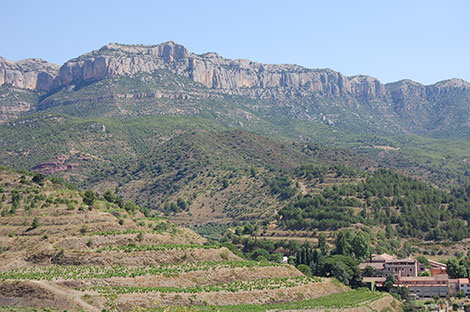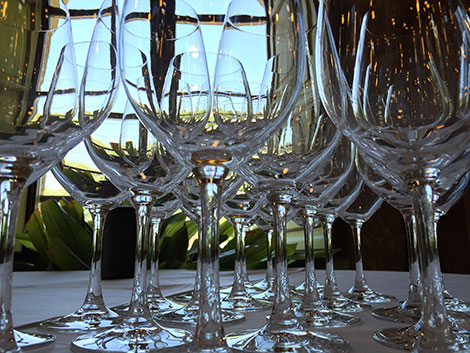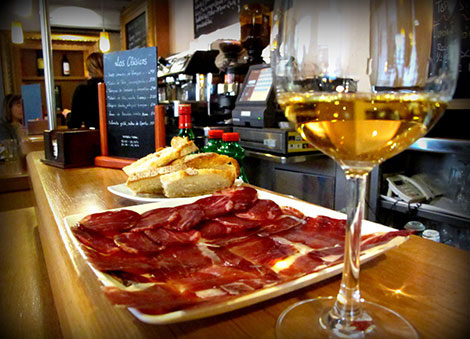
Ricard Rofes joined Cellers Scala Dei in 2007. He had previously worked in Montsant and in lower areas of Priorat making wines for Masroig’s Cooperative and later with architect Alfredo Arribas at his Portal del Montsant and Portal del Priorat projects. Rofes was therefore used to have Cariñena as a crucial ingredient in his blends so he was surprised to discover the minor role this grape variety plays in his new destination.
Escaladei is a hamlet in the district of La Morera del Montsant, but the area has its own special features. Firstly, this is Garnacha land; secondly, schist (locally called llicorella) is not the most significant type of soil and thirdly, altitude varies greatly with extra freshness at higher locations. Readers can see the Escaldei area marked in red on the map above based on the village classification established by DOQ’s Priorat in 2009.
The monastery was built at the foot of the Montsant mountain by the Carthusians after they settled in the region during the 12th century. This isolated area marks the boundaries between schist and other types of soil like clay (mainly red but also yellow) and chalk-limestone. Land diversity is thus a new element as well as exposure, altitude and varieties. Talking about his wines, Ricard Rofes doesn’t limit himself to grapes. He would describe Prior, for instance, as a blend of Garnacha, Cariñena, Syrah and Cabernet Sauvignon, but also adds that 60% of the grapes are grown on schist soils and the rest on clay.
A Garnacha-based project
Cellers Scala Dei owns about 40 plots at altitudes ranging from 400 to 800 metres. For some time now, vineyards have been handled separately in order to learn more about their particular features. The so-called “Garnacha” project aims to show this grape’s distinctive character in based on the different soils types in the Escadei area. The most singular plots, found within the Montsant Natural Park, were already worked by the monks at least 400 years ago.
Catalan historian Eugeni Perea i Simon refers to a manuscript found at Madrid’s Historical Archive with first inscriptions dating from 1629. Clearly written by one of Scala Dei’s monks, it offers detailed information about wine growing. For instance, Mataró (Monastrell/Mourvèdre) and Garnacha should be planted in cold soils as opposed to hot (arguably schist). The manuscript also explains how to produce Garnacha, Muscat, Malvasia wines and other sweet beverages like one called “Greek”.
A walk around the Montsant mountain
A few weeks ago I had the opportunity to visit some of the vineyards included in the “Garnacha” project. Winemaker Ricard Rofes drove me past the monastery’s ruins and up the mountain. The landscape in this area is rocky and rugged with vines planted in small terraces instead of steep slopes.
Our first stop was Artigots, two small terraces that hardly make one hectare. With distinctive stony soils, they stand at 550 metres of altitude. At this height, Rofes explained, stalks start to ripen simultaneously with grapes. This plot has only been vinified separately in 2010 and 2013 and it will most likely be withdrawn from the market.
Our next stop was Sant Antoni, a beautiful amphitheater-shaped vineyard located at 600 metres where red and yellow clay magically melt at its very centre. Harvest is usually done in three phases factoring in the different exposures and the fact that yellow clay gets less sun heat and grapes ripen more slowly. Yields are tiny, just half a kilo per plant, so it’s not surprising that only 1,200 to 1,800 bottles are produced per year. The monks built a small farm (mas in Catalan) to tend the estate in 1703. Legend has it that prior to the arrival of the Carthusians there was an old settlement in this area. As monks wanted to maintain their privacy and isolation at all costs, they patiently paid dowries to all the young ladies and acquired land in the area until Montalt, as the place was called, became depopulated.
Going uphill, we arrived at an east-facing vineyard at 680 metres of altitude where the new Scala Dei white comes from. It’s called Massipa, a name given to the land closest to the farm which was tended by the women. The wine is a blend of 80% White Garnacha and 20% Chenin Blanc, the latter dating from the late 1980s, both planted on red-clay soils with some gypsum.
Our last stop was both rewarding and breathtaking since we could enjoy amazing views of almost the whole Priorat. The biggest plot is Masdeu and it goes from 690 metres in its lower, red-clay area to 800 metres at its highest point where the land becomes chalky. Remoteness has been a double-edged sword: this is undoubtedly the most impressive Garnacha in the range, but the vineyard was poorly maintained. Hardly 2.5 of the 7 hectares were cultivated, but new plantings are being carefully worked through mass selection in order to preserve the distinct old Garnacha character.
Crop management has considerably improved since Codorníu, the majority stakeholder, proposed their partners (and vineyard owners) to rent all their vineyards in order to be directly managed by the winery’s vinegrowing team.
The new recipe: Garnacha, stems and concrete
Winemaking facilities are housed in the monks’ former stables, right in the centre of the small Escaladei village. Tanks vary from 1,000 to 10,000 litres with fermentations in open vats in order to obtain clean fruit aromas. “Garnacha is a major producer of sugar –points Ricard– so we also manage to get part of the alcohol to evaporate”. Over the last few years, winemakers have definitely learnt how to work with this grape: “Long maceration times used to be the norm so Garnacha was oxidized as there was no carbonic gas left for protection”, recalls Rofes.
The "Garnacha" project has been mainly inspired by the wines produced at Scala Dei in the 1970s and early 1980s, prior to the “Clos” movement led by pioneers Barbier, Pérez, Pastrana, Palacios and Glorian. Despite its short history (1974 was the first vintage), it seems obvious that these early Priorat, which used to ferment with stems in cement tanks, were aging better. Today, Rofes uses stalks in most of his Garnacha grown on non-schist soils —providing it is planted high enough to simultaneously ripen stems and grapes.
Younger Garnachas are fermented in stainless steel tanks with maceration lasting up to 13-14 days, but the most outstanding batches and those coming from old plots are vinified in cement vats. Usually grapes are left in a refrigerated truck through the night; then move onto a sorting table and are still cold enough to be macerated for roughly 3 to 5 days “in a liquid medium with no risk of oxidation if compared to a liquid-alcoholic solution environment once fermentation starts”, explains the Catalan winemaker.
Wine geeks may also be interested in learning about the simple, almost rudimentary pressing system used at Cellers Scala Dei. A thick piece of wood that fits perfectly in the vat is placed above a tank which is gradually filled with water. The process, which can take as long as 14 to 15 hours, produces an extremely fine press wine which is included in the final blends.
Aging is done in big barrels (no 225l. here) and foudres. Since the 2013 vintage concrete tanks are also used with part of the top single-vineyard Masdeu. Ricard Rofes thinks that Garnacha and concrete is a winning combination since this type of material doesn’t hold any barriers between the vineyard and the wine. The Masdeu sample I tasted after 19 months aging in concrete was extremely fresh, with well-defined fruit and a sort of Atlantic character that reminded me of some Garnachas from northern Navarra. The same wine aged in foudre had a lovely expression on the nose and felt rounder and softer on the palate. The final blend will probably bring more defined fruit to the wine, but is worth noting than 2013 is a distinctively fresh vintage in the area.
We will nevertheless have to wait some time to discover whether these 21st century reds can age as gracefully as some vintages from the 1970s. My best experience with Scala Dei’s relatively old reds was the 1975 vintage I had the opportunity to taste in Madrid a couple of months ago. What really fascinated me was the combination of a classic (could I say Rioja?) leather and spicy bouquet (clove, cinnamon) with Mediterranean herbs and some earthy notes that brought me back to Priorat. The palate had a lovely, silky texture yet showing a glimpse of lively acidity that I would seldom associate to this region and finished with an exotic ember edge. Wouldn’t it be a perfect choice to be included in a blind tasting of 1970s Spanish red wines? Any volunteers?

Amaya Cervera
A wine journalist with almost 30 years' experience, she is the founder of the award-winning Spanish Wine Lover website. In 2023, she won the National Gastronomy Award for Gastronomic Communication
NEWSLETTER
Join our community of Spanish wine lovers






